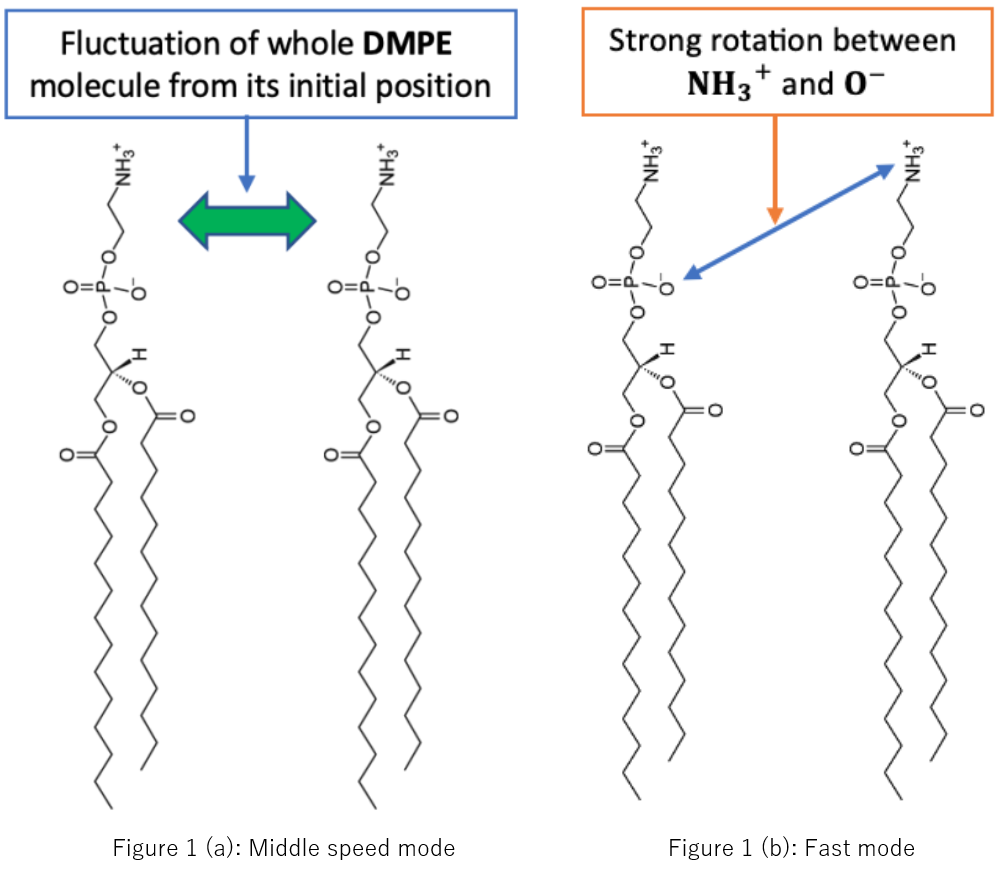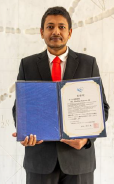2023.02.01
Origin of middle speed and fast headgroup dynamics of DMPE (1,2-dimyristoyl-sn-glycero-3-phosphoethanolamine) phospholipid by molecular dynamics (MD) simulation.
SOKENDAI Student Dispatch Program program year: 2022
MD. KHALIDUR RAHMAN

Figure 1 (a) and 1 (b) represent the middle speed and fast mode of the headgroup of DMPE, respectively.
Phospholipid bilayer is the main component between two living cells. The headgroup of the phospholipid bilayer is strongly connected with water named as hydration water. Intercellular communication strongly depends on the phospholipid bilayer as well as the hydration water. Two major phospholipids are 1,2-dimyristoyl-sn-glycero-3-phosphocholine (DMPC) and 1,2-dimyristoyl-sn-glycero-3-phosphoethanolamine (DMPE). Our group observed the translational (slow/middle speed) the translational (slow/middle speed) water dynamics water dynamics betweenbetween DMPC phospholipid bilayers by quasi-elastic neutron scattering (QENS).1 They suggested the relationship between the DMPC headgroup dynamics and hydration water dynamics. To investigate the relationship between the dynamics of the phospholipid headgroup and hydration water, we have done QENS experiments on the d54-DMPE+10D2O for the headgroup dynamics of DMPE phospholipid and d54-DMPE+10H2O for the hydration water dynamics. From the d54-DMPE+10D2O by QENS, we observed three types of DMPE headgroup dynamics, classified as slow, middle speed and fast mode. The slow mode sharply increases after the phase transition of DMPE which indicates that the slow mode is originated from the DMPE membrane. But the QENS is unable to reveal the origin of the middle speed and fast headgroup dynamics of DMPE. To reveal their origin, we performed molecular dynamics (MD) simulation. MD simulation revealed that the middle speed mode originated due to the fluctuation of the whole DMPE molecule from its initial position. And the fast mode of DMPE originated for the strong rotation between NH 3 + and O - in the DMPE. Understanding the above-described study surely develop the knowledge for the preparation of phospholipid based biocompatible materials in artificial organs. Reference: [1] Yamada et al., J. Phys. Chem. B 2017, 121, 8322.
Period of Stay
Date of Departure: 2022/08/01
Date of Return: 2022/10/31
Country and/or City
Japan
Visiting Institute, Host, or Meeting
Research Institute for Information Technology, Kyushu University
What you learned and achieved during the visit
Analyzed headgroup dynamics of DMPE phospholipid by MD simulation and wrote a draft writing on it for the scientific
journal. Learned the MD simulation, the input file preparation from Charmm-gui for the MD simulation, and the technique to use supercomputer. Successfully making graphs and snapshots from the MD simulation results.
Department of Material Structure Science. MD. KHALIDUR RAHMAN

I am a Ph.D. student of "Soft Matter Group", IMSS, KEK, SOKENDAI. For a part of research of my Ph.D. thesis, I have been awarded as "Young Scientist" by "The 73rd Divisional Meeting of Division of Colloid and Surface Chemistry" on September 20-22, 2022, for the oral presentation on the title "Hydration water dynamics between DMPE (1,2-dimyristoyl-sn-glycero-3-phosphoethanolamine) phospholipid bilayers". Interestingly, I also explained there about the origin of the headgroup dynamics of DMPE by the MD simulation. In my photo, I shared certificate of the award.
